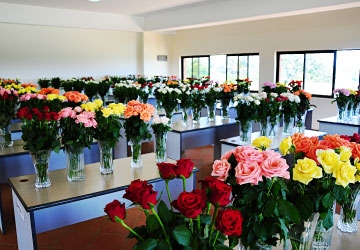Ruparelia Group is among global top players in the floriculture market, according to the latest Global Industry Insights, Trends, Outlook, and Opportunity Analysis, 2018-2026.
Ruparelia Group runs two companies- Rosebud Ltd. and Premier Roses Ltd. which export the flower products. The two companies in October 2017 received Free Zone licenses from Uganda Free Zones Authority to grow more flowers in Namulanda Parish, Ssisa Sub-county, Wakiso District.
The company has also targeted Masaka and Kulkungu districts for flower growing.
Based in Entebbe, Uganda, Premier Roses is the country’s largest exporter of roses, with around 40 percent of Uganda’s export market. The green houses on the farm cover a total of 50 hectares producing and exporting over 12 million stems per month.
Premier Roses Ltd solely specializes in the production of quality cut roses for export onto the world market.
The company produces two categories of roses: Sweetheart Roses; Valentino (dark red), Viva (bright yellow), Chelsea (orange), Red Calypso (bright red), Meera (champagne), Akito (white), Blushing Akito (pink), Raspberry King (dark red), Jambo (bright red). Intermediate Roses include; Ace Pink (pink), Bella Rose (pink), Sunny Star (yellow), Furiosa (dark red), Tropical Amazone (orange), Banjo (pink), Labelle (peach), Sorraya (yellow), Athena (white).
According to the latest analysis, mergers and acquisitions, strategic collaborations, and new product launches are the key strategies adopted by the players in the floriculture market in order to retain their market share.

The analysis lists other major players operating in the global floriculture market as; The Kariki Group, Dummen Orange, Syngenta Flowers. Inc., Karuturi Global Limited, Oserian Development Company Limited, Selecta Klemm GmbH & Co. KG, Carzan Flowers K Ltd., Multiflora Ltd., and Karen Roses.
Market classification
Based on the product type, the floriculture market is segmented into: Cut flowers, pod plants, cut foliage, bedding plants and others like bulbs and corms.
Based on the application, the floriculture market is segmented into: Decoration, cosmetics, perfumes pharmaceuticals and others.
Furthermore, according to the International Trade Center (ITC), the global export of floriculture products has increase exponentially over the last few years. In emerging economies including India and China among others, the global export was recorded at US $4.00 billion in 2012, which was 24 per cent higher as compared to the exports in 2010, according to ITC.
Market dynamics
According to the analysis, major factors propelling growth of the global floriculture market include steadily developing plant biotechnology including genome sequencing, which results in increased yield and development of genetically modified flowering plants. For instance, Suntroy Flowers Ltd., a company based in Japan, developed the world’s first blue rose with 100 per cent blue-pigmented petals. The company started selling its blue rose, under the brand name Applause, throughout Japan in 2011.
Furthermore, owing to adoption of novel technologies and more precise management in commercial floriculture, profit of floriculture products per unit area is higher as compared to other agriculture products. Thereby, the higher profitability, is considered as another factor, leading to growth of the global floriculture market. Moreover, growing demand for essential oil of rose, tube rose, and jasmine among others, is propelling the market growth. For instance, according to Coherent Market Insights’ analysis, the global consumption of essential oils is anticipated to grow from US $8.29 billion in 2016 to US$ 15.01 billion in 2025.
Global Market Outlook
Asia Pacific is projected to record a significant growth in the global floriculture market during the forecast period. This is attributed to presence of largest flower producing countries such as India and China in the region. Owing to growing demand for flowers, floriculture in India is emerging as an important commercial trade in agriculture. According to the Agriculture & Processed Food Products Export Development Authority (APEDA), in India, around 248.51 thousand hectares area was reported as under cultivation in floriculture during 2014-2015 and the production of flowers was estimated to be 472 thousand tons cut flowers and 1,658 thousand tons loose flowers during 2014-2015 in India.
Furthermore, Indian floriculture industry is shifting from traditional flowers to cut flowers, in order to support growth of their export business. For instance, according to the Ministry of Agriculture & Farmers Welfare, India had produced 0.69 million metric tons of cut flowers during 2015-2016 and according to the APEDA, during 2016-2017, countries including Germany, the U.S., the U.K., and United Arab Emirates were major importers of the Indian floriculture.
In Europe, Netherlands is the largest producer and exporter of the floriculture products. According to the data provided by the USDA Foreign Agricultural Service in 2016, Netherland was reported as the dominant exporter of the floriculture products including cut flowers and bulbs, and in 2015, the total export of the country for floriculture products was reported as over 9 billion, out of which, 1 billion corresponds to bulbs only, according to USDA. Tulip dominated the bulbs export of Netherlands in 2015, among hyacinth, narcissi, and gladioli bulbs.
Furthermore, growing demand for cut flowers and higher imports in Germany and other European Union countries such as France, is driving the growth of floriculture market in the region. For instance, according to the European Union, the total imports of cut flowers and cut foliage in EU was reported as 294.24 Kilo tons in 2013. Moreover, cut flowers and cut foliage segment dominated the total imports of floriculture products in EU with 78.3 per cent in 2014, among potted plants (15.6 per cent) and bulbs and corms (4 per cent), according to the European Union.





